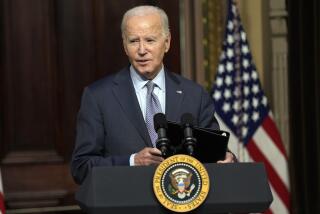Clinton May Fall Short on Easing Unemployment
- Share via
The incoming Clinton Administration has vowed to place job creation at the center of its economic agenda. But I am not yet persuaded that Clintonomics will make much of a dent in the persistent problems of unemployment in the U.S. economy.
Some aspects of the Clinton economic package are certainly welcome and promising. Through the President-elect’s strong emphasis on public investment and government involvement, for example, he provides some hope that we can finally move beyond the self-defeating insistence by the right-wings that government should simply get out of the economy’s way.
In our leading competitors such as Germany and Japan, the government effectively shepherds the economy, provides support for infrastructure, research and development, investment financing, worker retraining and export marketing. Thankfully, the Clinton Administration plans to follow their lead, hoping to drag the U.S. economy into the 21st Century.
But this concentration on government economic support does not go far enough. Let’s look more closely at what it would take for the Clinton program to deliver on the job front.
Though Clinton advisers promise to provide more jobs for the millions who need them, the actual planks of Clintonomics, as revealed during the campaign, aim primarily at improving long-term productivity growth, not directly at providing employment. And here we encounter a serious potential problem.
If the rate of productivity growth accelerates, as the Clinton economists hope, businesses will need fewer workers to produce their output. So if nothing else changes, productivity growth could actually erode employment, with fewer workers hours required to produce a given level of goods and services.
Historically, facing this dilemma, most economies have encouraged shorter work hours as a way of sharing the work in a dynamic economy. But since the 1960s the number of hours worked has increased in the U.S., not declined.
Harvard economist Juliet B. Schor estimates that American workers are now putting in, on average, nearly a month’s worth of hours more per year than they were in the late 1960s.
Why? Among the reasons is that real wages have been stagnating and, since the late 1970s, actually declined. Most people could hardly afford to cut their working time when they needed to race just to stay in place.
Consequently, if the Clinton Administration seriously wants to combine productivity growth and employment expansion, it needs to tackle the problem of low and declining earnings in the private sector as well as the problem of rising--rather than falling--hours worked.
On the wage front, for example, this would require substantial increases in the purchasing power of the minimum wage and serious efforts to reverse the corrosive decline in private-sector unions.
The Clinton program proposes neither. It provides a token commitment to increase the minimum wage just fast enough to keep up with the pace of inflation--which would maintain the real value of the minimum wage at its current levels rather than increasing it.
And all it promises on the union front is an effort to ban permanent replacements for striking workers. This falls far short of the more substantial efforts necessary to level the playing field for workers who would like to form unions; it would do little to reverse the trend toward falling wages.
On the work-hours front, the Clinton program is virtually silent. But there are steps the new Administration could take to encourage workers and firms to move toward more flexible and fewer work hours.
For example, the federal government could enact legislation guaranteeing every worker (employed, say, at least 17 hours of work a week) a minimum of three weeks vacation a year. (In many European countries, five weeks guaranteed vacation is common.)
This would provide a boon to workers, providing them with an incentive to work more effectively on their jobs and potentially boosting productivity. And it would also create pressures toward work-sharing, with firms hiring additional employees to fill in for vacationing workers.
However, there are substantial reasons for concern. If you look at the actual planks of Clintonomics, its highest priority is improving competitiveness by increasing the rate of productivity growth. But there is no reason to feel confident that the new Administration will take some of the critical steps necessary to protect against the employment-dampening effects of accelerated productivity growth.
Will the new Administration take direct action to promote employment expansion?
Here, there is also little more reason to feel confident. As noted above, the new Administration proposes a major program of new public investments, especially in infrastructure and education. It is likely to try to finance much of this new public investment from gradual reductions in the defense budget, while maintaining its firm commitment to reduce the federal budget deficit over the next five years.
The public investments promised by the Clinton program are important and necessary, but there are two reasons for doubting that these initiatives will do much on the employment front.
First, gradual reductions in the federal budget deficit will tend to dampen economic growth, not accelerate it. As long as there is such strong pressure to reduce the budget deficit over the medium term, the federal government will not be in a position to boost employment.
Second, this means that the employment-generating impact of the proposed public investments would have to be substantially greater than that of the defense expenditures they would be replacing.
But this may not be the case. Some military expenditures, such as wages and salaries for military personnel, have a substantial direct employment impact. And some of the kinds of public investments proposed in the Clinton plan would involve fairly capital-intensive expenditures, such as highway, bridge and sewer revitalization and exploration of new transportation technologies.
On balance, I have not seen clear demonstrations that the employment impact of the new public investments would be more favorable than the defense programs they would be replacing. And so, still on balance, I am not persuaded that the Clinton program will do much to boost employment.
Some Clinton initiatives will be likely to improve U.S. economic performance. But I wish I could feel more hopeful for those millions of Americans who desperately need a job.
More to Read
Get the L.A. Times Politics newsletter
Deeply reported insights into legislation, politics and policy from Sacramento, Washington and beyond. In your inbox twice per week.
You may occasionally receive promotional content from the Los Angeles Times.










